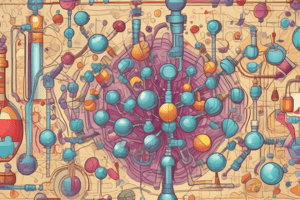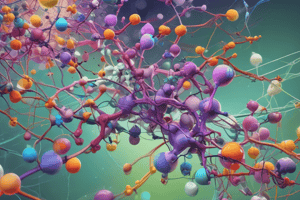Podcast
Questions and Answers
What was the first effective antibacterial agent discovered in 1935?
What was the first effective antibacterial agent discovered in 1935?
- Prontosil (correct)
- Streptomycin
- Chloramphenicol
- Penicillin
Which class of antibiotics were the only effective antibacterial agents until the discovery of penicillins in the 1940s?
Which class of antibiotics were the only effective antibacterial agents until the discovery of penicillins in the 1940s?
- Aminoglycosides
- Sulfonamides (correct)
- Cephalosporins
- Tetracyclines
Which alcohol has been found to exhibit the highest antibacterial potency against Staphylococcus aureus?
Which alcohol has been found to exhibit the highest antibacterial potency against Staphylococcus aureus?
- Methanol
- Ethyl alcohol
- Octanol (correct)
- Isopropyl alcohol
What is the result of increasing the primary alcohol chain length in terms of its interaction with microbial membranes?
What is the result of increasing the primary alcohol chain length in terms of its interaction with microbial membranes?
What concentration of alcohol is accepted as bactericidal, despite findings that different concentrations have similar kill rates for microorganisms?
What concentration of alcohol is accepted as bactericidal, despite findings that different concentrations have similar kill rates for microorganisms?
What is the definition of an antibiotic?
What is the definition of an antibiotic?
Who is credited with developing the principle of chemotherapy?
Who is credited with developing the principle of chemotherapy?
When was the first synthetic antibacterial agent developed?
When was the first synthetic antibacterial agent developed?
What did Paul Ehrlich name the chemical that directly interferes with the proliferation of microorganisms?
What did Paul Ehrlich name the chemical that directly interferes with the proliferation of microorganisms?
Who first identified the presence of bacteria in 1670?
Who first identified the presence of bacteria in 1670?
Flashcards are hidden until you start studying
Study Notes
Antibacterial Agents and Antibiotics
- The first effective antibacterial agent was discovered in 1935, although the specific type is not mentioned.
- Until the discovery of penicillins in the 1940s, sulfonamides were the only effective antibacterial agents.
Antibacterial Properties of Alcohols
- Isopropanol has been found to exhibit the highest antibacterial potency against Staphylococcus aureus.
- Increasing the primary alcohol chain length results in reduced interaction with microbial membranes.
Antibacterial Concentrations
- A concentration of 60% is accepted as bactericidal, despite findings that different concentrations have similar kill rates for microorganisms.
Antibiotics and Chemotherapy
- An antibiotic is defined as a substance that inhibits the growth of microorganisms or destroys them.
- Paul Ehrlich is credited with developing the principle of chemotherapy.
- The first synthetic antibacterial agent was developed in 1935.
History of Microbiology
- In 1670, Antonie van Leeuwenhoek first identified the presence of bacteria.
- Paul Ehrlich named the chemical that directly interferes with the proliferation of microorganisms as "magic bullets".
Studying That Suits You
Use AI to generate personalized quizzes and flashcards to suit your learning preferences.




